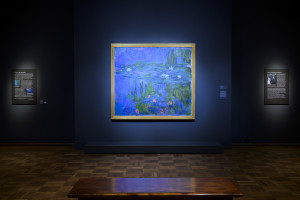

On Tuesday, May 13, 2025, at 11.30 a.m. Joseph Gallivan interviews the Portland Art Museum’s chief conservator, Charlotte Ameringer. Charlotte talks about her work restoring Claude Monet’s famous 1914 painting “Waterlilies” which he painted at his home in Giverny in France. As well as explaining how removing the painting’s acrylic resin varnish shows off the colors in new ways, she explains the importance of the painting in Monet’s late stage career, his use of different brushstrokes, and how he and other Impressionists were influenced by Japanese woodblock prints. The show “Monet’s Floating Worlds at Giverny: Portland’s Waterlilies Resurfaces” is on now at the Portland Art Museum through August 10, 2025.
From the press release:
https://portlandartmuseum.org/event/monets-floating-worlds-at-giverny/
Overview
The monumental canvas Waterlilies by Claude Monet is perhaps the most treasured painting in the Portland Art Museum’s collection. Now, after over 65 years, it will finally look much as the artist intended—without varnish. The detailed process of conservation resulted in new color harmonies and brightness. To celebrate the restoration of the painting and the campus transformation project, this beloved icon will be presented in its historical context. Monet and his fellow Impressionists were obsessed with Japanese “floating world” prints that had only been available in Europe and the United States for a few decades, yet transformed the way artists looked at the world. They introduced new concepts of beauty and new ways of seeing the world that decentered the European tradition.
Monet’s startlingly disorienting composition is without a horizon line or depth. It combines floating leaves, blossoms, and the reflections of hanging willow branches, with the suggestion of raindrops, resulting in a mesmerizingly contemplative image of nature. Yet the nature in Portland Art Museum’s Waterlilies painting is artificial—a pond constructed by Monet, stocked with waterlily specimens imported from all over the world, and tended by eight gardeners. Monet created over 250 paintings of his waterlily pond in his final years, an astonishing project.
Monet decorated his expansive house in Giverny, France, with a selection of the hundreds of important woodblock Japanese prints he had collected by masters such as Toyokuni, Hiroshige, and Utamaro. Visitors will experience a recreation of Monet’s collection with prints from the Museum’s Asian Art collection in a section called Monet’s Japanese Prints; followed by a section on the Impressionist and European response to Japanese artists, with works by Henri Rivière, Édouard Vuillard, Jules Chéret, and others. Lastly, the newly conserved painting will be presented alongside the story of the research and restoration project. Waterlilies will be joined by contemporary photographs of Giverny and Portland’s Japanese gardens by Susan Seubert and Stu Levy.
Co-organized for the Portland Art Museum by Charlotte Ameringer, Chief Conservator, Mary Weaver Chapin, Ph.D., Curator of Prints and Drawings, Lloyd DeWitt, Ph.D., The Richard and Janet Geary Curator of European & American Art Pre-1930, and Jeannie Kenmotsu, Ph.D., The Arlene and Harold Schnitzer Curator of Asian Art.
Special note: I am looking for work as a writer/broadcaster right now.
Find me on LinkedIn and refer me to your friends who appreciate art or writing or both.
KBOO’s Fundraiser 2025
Where do you get your art content?
Just go to kboo.fm/give or text K-B-O-O to 44-321.
We need your money.
Art Focus on K-B-O-O Portland is the show where artists talk about their work.
KBOO is a volunteer-powered community platform. That means we are funded by you, the listener.
To hear previous episodes of Art Focus or any of our KBOO public affairs programming, just go to KBOO dot F-M or listen on iTunes, Google Play, or wherever you get your podcasts.
Joseph Gallivan has been a reporter since 1990. He has covered music for the London Independent, Technology for the New York Post, and arts and culture for the Portland Tribune and for Axios Portland. He is the author of two novels, "Oi, Ref!" and "England All Over" which are available lightly used.
- KBOO



